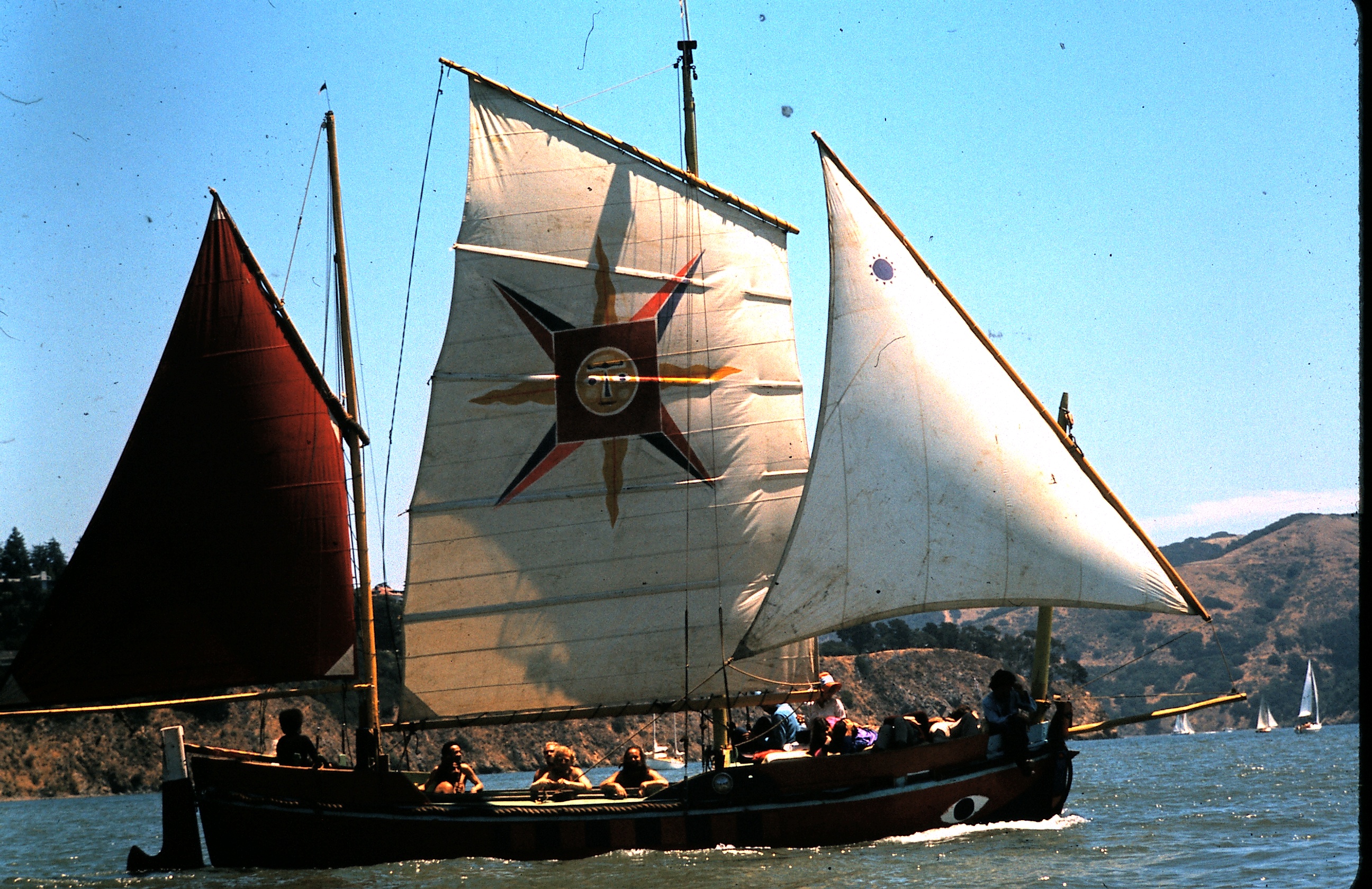Sunday Sails with Varda
 Thursday, July 16, 2015 at 06:39PM
Thursday, July 16, 2015 at 06:39PM By Betsy Stroman
The following is excerpted from Betsy’s new book, “The Art and Life of Jean Varda.”
Jean (Yanko) Varda, the collage artist who moved onto the old ferryboat Vallejo on the Sausalito waterfront in the late 1940s, was an avid sailor. He built his first boat at the age of 12, while living in Smyrna, a port city in the ancient Ottoman Empire, and he liked to tell people that his first profession was that of a boatbuilder. During the more than twenty years he lived on the Vallejo, he built several sailboats. The larger ones all shared a distinctive design. He converted them from old metal lifeboats, readily available on the Sausalito waterfront at the time for about sixty dollars. Most of his sailboats had a lateen or triangular sail, mounted at an angle on the mast, commonly featured on the boats that fishermen in the Mediterranean sailed.
Varda frequently painted eyes on the hull of his boats. Some speculated that the eyes kept people safe on the boat, but many people thought that Varda himself had a protective magic. In an interview with Sausalito writer Annie Sutter, the artist Gordon Onslow Ford, who for a time shared the Vallejo with Varda, explained that Varda “was a Greek sailor from ancient times … a lucky person. … He was quite fearless and would put to sea with his cargo of beauties and they never came to any harm.” Friends who sailed with Varda claimed that, to the astonishment of proper yachtsmen, he could “whistle the wind,” by which they meant that when he whistled, he brought the wind, and the boat sailed faster.
Varda built the first of these boats. the Chimera, in the early 1950s, a few years after moving onto the Vallejo. Writing to a friend, he reported, “My sailing boat is a marvel and with a crew of the choicest I spend my Sundays in the Bay. We generally go out 18 of us with gallons of wine, with tons of food, with singers & musicians.”
The Chimera was followed by the Perfidia. Alan Watts, the writer and Zen popularizer who lived on the Vallejo with Varda beginning in the early 1960s, described the Perfidia as “the bravest boat on the Bay, with eyes on the prow, a broad band of vivid red below the gunwale, and a honey-colored lateen sail.“ As in the past, Varda and his friends would spend Sundays sailing on the bay, well supplied with bread, cold chicken, and gallons of wine. “Seeing this craft gliding in full sail by the wooded cliffs of Belvedere,” Watts wrote, “it was impossible to believe that this was the United States and not the islands of Greece.”
Varda refused to install a motor on his earlier boats, and there were times when the sailing parties ended up becalmed, or the tides were going the wrong way. When a motorboat came by, according to Varda’s friend Alexis Tellis, who accompanied him on many of these outings, sometimes Varda shouted, “Give us a tow and we’ll give you a girl.” Varda got a lot of tows, Tellis added, but he never gave them a girl.
In the fall of 1966, Varda, along with some young helpers, began working on his last sailboat, the Cythera. By this time Varda had reluctantly become convinced that a motor would be a good idea and one was installed. The Cythera ended up much larger than any of Varda’s earlier sailboats. In addition to the customary lateen sail, red in this case, there was a yellow mainsail, painted with a sun, and a white American jib. “When the Cythera is fully rigged she resembles an exotic Chinese junk,” one of Varda’s friends wrote. “No one would guess the craft is a resurrected rusty iron-hulled lifeboat.”
Sunday sails on the Cythera frequently included as many as 40 guests, who would board the boat, dressed in their most colorful garb, and scramble to find cushions in the hull. Yanko sat on a box and give orders to the crew — friends who knew how to sail. In short order, two or three bottles of burgundy would be uncorked. An old piano top, hoisted across the motor, served as a table. It was soon heaped with cold marinated liver, French bread, cheese, and other delicacies. As the guests sat and enjoyed the food and wine, Varda would begin to talk about painting, or tell one of his fabulous stories.
Young women who boarded the boat in their colorful but filmy hippie garb in the early afternoon would soon find that they were freezing. Varda, the ever thoughtful host, kept a bunch of old coats, which he had bought at Goodwill, on board, and the young women would be very pleased when Varda came by with a glass of wine and draped a coat around them.
One of Varda’s friends from that era, Margaret Fabrizio, who sometimes joined the Sunday sails, later recalled that often fancy yachts sailing on the bay would make a special trip to the boat “to get Varda’s blessing.” People just wanted to have some kind of interaction with Varda, she said. There was something about the kind of energy and joy that emanated from his colorful homemade boats and its colorfully clad occupants that attracted those expensive yachts like a magnet.
From June 1 to July 13. The Historical Society is proud to sponsor an exhibit of Varda’s works at the Bay Model. 
Jean Varda’s Cythera under sail
Photo from Varda family archives

Reader Comments